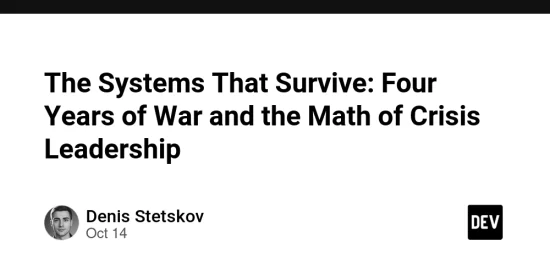It’s 3:00 PM on October 10, 2025. I’m sitting in my apartment in Kyiv, working on my laptop, which is connected to a backup power supply. The electricity went out at 3:00 AM—12 hours ago. Explosions this morning. Another massive strike on energy infrastructure.
This is the fourth war for electricity.
My wife and I no longer go to the shelter. We’ve adapted. Everyone has. The team is online, working as usual. One engineer messaged the Telegram channel at 10:00 AM: “On backup power, all good.” Another at 2:00 PM: “Generator kicked in, continuing yesterday’s task.”
This wasn’t heroism. This was Friday.
The War That Started in 2014
For my wife and me—my girlfriend back then—the war didn’t start in February 2022. It started in 2014. We’re from Luhansk. We left our home for what we thought would be a short period, only a few months. That was 11 years ago. The city is still occupied.
I experienced displacement once. I know what it means to pack everything for “a few months” and never return.
That’s exactly why I’m staying now. I’m not doing that again.
I have circumstances that would allow me to leave Ukraine. Many of my teammates don’t—men can’t cross the border, they’re in the reserve. But I’m not leaving.
I’ll be here as long as possible. If it’s possible, I’ll stay permanently. This isn’t uncertainty. This is a decision.
February 24, 2022: When Everything Stopped
I’m a Tech Lead at NineTwoThree, a Boston-based software agency with 30+ engineers. We build products for American clients. I work from Kyiv, managing our engineering team. When the war started, 25 of our teammates were in Ukraine—engineers, PMs, QA, designers.
The first month after the full-scale invasion, I barely appeared at work. My wife and I drove people to the train station, evacuating them from suburbs near active combat zones. We bought supplies for shelters. We picked up military rations around the city and delivered them to soldiers. We distributed food to abandoned animals.
It couldn’t continue like that—complete absence from the company.
The lifeline was IDS: Identify, Discuss, Solve. Every day, 30 minutes, putting out fires. Management only—no broader team involvement. Where I could be present even when I wasn’t fully present. Where we could continue making decisions and holding the company together despite everything happening around us.
That daily 30-minute process became our anchor. It still runs today—four years later. Same format, same time, different fires.
On day one, we created a dedicated Telegram channel with all our Ukrainian teammates. Three questions tracked daily: Are you safe? Where are you? How are your parents? Those check-ins became routine, not emergency protocol.
Four years later, after every massive strike, we’re still in that same channel. Same three questions. Checking everyone’s status. The system built on day one still works.
That story is documented. What’s not documented is what happened after those first days turned into weeks, then months, then years.
October 23, 2022: The First Blackout
The national blackout hit when nobody was ready. 55% of Ukraine’s power grid went dark in a single day. No backup power supplies. No backup internet. No preparation.
I was in Kyiv. Experienced it firsthand. The team worked when the electricity came back on, trying to accumulate as many hours as possible and trying to meet deadlines during the brief windows of power.
Meanwhile, the global IT industry was making a different calculation.
While Ukrainian developers proved they could work through blackouts, companies were cutting Ukrainian teams. By October 2022, the recruiting portal Djinni showed 64,000 candidates and only 16,000 vacancies. The math was brutal: developers were losing jobs, salary expectations were dropping, and the world was hedging its bets elsewhere.
Some companies evacuated teams and never came back. Some stopped signing new contracts with Ukrainian vendors entirely.
We made a different choice.
Building Systems During Crisis One
While experiencing that first blackout—while the team was working in brief windows of electricity—we were already building systems for the next one.
Looking for Backup Capacity
During those first blackouts, we reached out to agencies with teams outside Ukraine. Started interviewing people beyond Ukraine’s borders. We didn’t hire anyone—we kept our Ukrainian team fully employed and supported—but we needed to understand who could pick up work if our primary resources became unavailable due to blackouts, communication issues, or infrastructure damage.
We were mapping backup capacity, not replacing people.
Financial Support Systems
The point wasn’t the specific amounts or programs. The point was to show our teammates that no matter what happened, the company was with them.
We built concrete support mechanisms:
Covered 50% of the costs for backup power supplies for anyone who asked
Paid for coworking spaces with generators and Starlink
Team fundraising for the military: whatever amount the team collected monthly to donate to the Ukrainian Armed Forces, the company doubled it (if the team collected $20k in donations, we added another $20k)
Not because we had unlimited resources. Because we needed our teammates to feel we were standing beside them, regardless of what came next.
Process Clarity
Built explicit processes for working during blackouts
Set clear expectations: which hours count, which don’t
Removed ambiguity from an ambiguous situation
When Mobilization Came
In Ukraine, men aged 24-60 cannot leave the country—they’re in the reserve for potential mobilization. Many wives stay with their husbands because of this. Our team isn’t in Ukraine by choice alone; for most, it’s the only option.
I have circumstances that would allow me to leave. I choose not to.
Two of our teammates were mobilized.
The first engineer: A refugee from Kherson, which fell under occupation. He ended up in Lviv as a displaced person. One day, mobilization arrived there. He was sent to England for training—specialized military instruction. After training, he was assigned to the 81st Air Assault Brigade.
When we learned where he was going, we understood: this is serious. The 81st is one of the most intense combat units in Ukraine’s military.
He’d already lost his home city to occupation. Then he served in one of the toughest brigades.
He was demobilized due to family circumstances. Kherson was liberated in November 2022, but he couldn’t return home—the city is shelled daily, and it is too dangerous to live. Now he’s safe in Spain with his family.
The second engineer: From my direct team. They came to his home with a mobilization notice. I just showed up and handed him the papers.
In the first nine months, his brigade was forming, training, organizing, and preparing. But he was already serving in an officer position as a communications specialist.
He’s still fighting. Still serving. Still on active duty today.
For both mobilized team members, we cover 50% of their salary. If someone else is mobilized, we will continue in the same manner. It’s not much compared to what they’re doing, but it’s what we can do.
Summer 2023: The Moment I Knew
After the summer counteroffensive in 2023, I understood this was going to last for years. Not weeks. Not months. Years.
That realization changed everything. It meant the systems we built weren’t temporary accommodations—they were the new operating model.
What the Industry Doesn’t Talk About
Global tech companies laid off 93,000 workers in 2022 and more than 200,000 in 2023. The reasons varied: post-pandemic correction, economic uncertainty, and cost-cutting.
However, for Ukrainian developers, there was an additional factor that nobody wanted to mention out loud: geopolitical risk.
Companies didn’t announce “we’re cutting Ukrainian teams because of the war.” They just quietly stopped hiring. Stopped renewing contracts. Started looking elsewhere.
We went in the opposite direction. While others were reducing their exposure to Ukraine, we were building systems to make that exposure sustainable in the long term.
The Reality Nobody Romanticizes
Here’s what people get wrong when they talk about Ukrainian resilience in tech:
It’s not heroism when engineers work through air raid sirens. It’s not inspiring when someone messages, “on backup power, all good,” and continues working.
It’s survival. People work because there’s nowhere else to go. Because routine provides sanity. Because paying rent still matters even when missiles are falling.
The systems we built didn’t create heroes—they made survival operational.
What “Working Through War” Actually Means
Engineers work from home on backup power when the grid is down for 12+ hours daily.
During the first year, before everyone had backup power, some worked from coworking spaces with generators.
Now everyone has set up their own backup systems and works from home
“Explosions nearby, taking a 30-minute break” is a standard Slack message
Infrastructure can fail without warning—power, internet, communications
We plan around that uncertainty because we value our team and the people in it…
Years Two, Three, and Four: The Dividends of Early Preparation
The second blackout campaign in 2023 had a different impact. We were ready. The team had backup power. Coworking spaces were already contracted. Everyone knew the process.
The third blackout campaign in 2024—same thing. Less disruption each time.
Now, the fourth campaign—October 2025—I’m sitting on backup power for 12 hours, and the company is operating at near-normal capacity. Not because the situation improved. Because the preparation from year one carried through years two, three, and four.
The pattern: Each subsequent crisis hits less hard because you built systems during the previous one.
This isn’t unique to war. It applies to any sustained crisis, such as a pandemic, economic collapse, or industry disruption.
The companies that survive are those that prepare for the next crisis while managing the current one.
The Math That Actually Matters
Over four years of war, while other companies were cutting Ukrainian teams and hedging their bets, we did the opposite.
The result: our ARR grew 3x.
Not despite the war. Because we built systems during crisis one that let us operate through crises two, three, and four. While competitors were dealing with instability and team turnover, we were shipping products for American clients without interruption.
The systems we built weren’t just about survival. They aimed to build a company that could thrive under the most challenging conditions.
Client retention remained high because we were transparent about constraints and reliable in our delivery. Team retention stayed at 95%+ because people felt supported, not abandoned. Growth happened because we invested in infrastructure when others were cutting costs.
The fourth blackout is easier than the first—not because the situation improved, but because we built systems in year one that carried through years two, three, and four.
That’s the only predictable pattern in sustained crisis:
the systems you build during crisis one determine whether you survive crisis four.
And if you build them right, you don’t just survive. You grow.
P.S. – For Ukrainian teams still operating during the war: you’re not alone. For companies working with Ukrainian teams: consistency and transparency matter more than inspiration. And for everyone else: the best time to prepare for the next crisis is during the current one.







